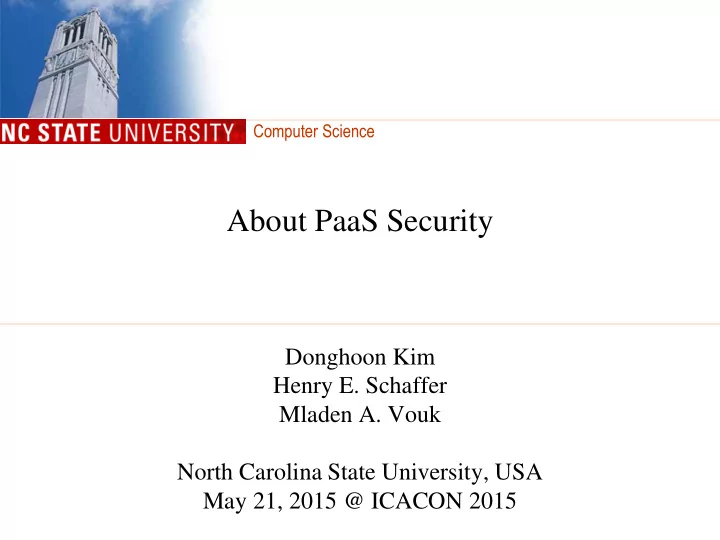

Computer Science About PaaS Security Donghoon Kim Henry E. Schaffer Mladen A. Vouk North Carolina State University, USA May 21, 2015 @ ICACON 2015
Outline • Introduction – Background – Contribution • PaaS Vulnerabilities and Countermeasures – Software Platform Cloud Applications Features: (SaaS) • Runtime environments – Virtualization Cloud Software Environments • Database (PaaS) • Web server – Data Security & Integrity • Development tools Cloud Software Infrastructure • Programming environments (IaaS) • Etc. Operating Systems • Some Security Trends Hardware Vulnerabilities – Isolation for multi-tenant environments SW Platform Side1 channel* a4acks Virtualization – Protection of sensitive data Data Protec' ng* sensi' ve* data Computer Science 2
Introduction: Background • Three Service delivery model for cloud computing – Defined by NIST Cloud Applications (SaaS) • SaaS (Software) Cloud Software Environments (PaaS) • PaaS (Platform) Cloud Software Infrastructures • IaaS (Infrastructure) (IaaS) Operating Systems • PaaS (Platform as a Service) Hardware – Provide middleware resources to cloud customers (E.g., developers and providers of SaaS) – Hide complexity of maintaining the infrastructure – Enable low costs and higher computing efficiency • Surveyed over the last five years (i.e., since 2010) – Research papers, industrial technical reports, etc. Computer Science 3
Introduction: Contribution • Three categories of PaaS security issues – Vulnerabilities and corresponding countermeasures • PaaS security trends – Isolation for multi-tenants against side-channel attacks – Protection of sensitive data Cloud Applications Features: (SaaS) • Runtime environments Cloud Software Environments • Database (PaaS) • Web server • Development tools Cloud Software Infrastructure • Programming environments (IaaS) • Etc. Operating Systems Hardware Vulnerabilities SW Platform Side1 channel* a4acks Virtualization Data Protec' ng* sensi' ve* data Computer Science 4
Software Platform (1/2) • OS to Hypervisors and Virtual Platform (VP) (e.g., Java and .NET platform) • The limitation of achieving proper isolation for multi-tenants – OS limitation as a hosting environment (i.e., PaaS Platform) • PaaS providers may prefer simplified abstractions • OS may not support a set of applications; • Need tuning depending on each application – Proper isolation mechanisms with three options • Isolation at OS level • Isolation at Standard Java Security • Isolation at VM level Computer Science 5
Software Platform (2/2) • Main open security issues at different layers – OS, Java VM, Container • Container for controlled environments – Dockers released in March 2013 • Resource isolation features of the Linux kernel • Provide lightweight containers to run processes in isolation. • The user needs to “own” the whole stack for complete isolation. – Bare machine or sole-use may be the only safe solution Computer Science 6
Virtualization (1/2) • Major components of cloud computing • Drive the growth of clouding computing • Enabling sharing of resources for multi-tenancy • Multi-tenancy vulnerabilities – The adversary may identify internal cloud structure which can launch a comprised VM – Cross-VM side channel attacks due to the sharing of physical resources (e.g., a single core CPU, cache) • Countermeasures – Cloud providers may obfuscate both internal structure of their services and the placement policy – Avoid co-residence – Expose the risk and placement policy directly to users Computer Science 7
Virtualization (2/2) • Vulnerabilities – Components sharing between VMs, but lack of isolation • Countermeasures – Strong isolation, nevertheless a large overhead • Performance between isolation and consolidation • Major cause: contention on memory channels or processor caches on the physical machine – Physical and functional hierarchical • Functional: divide a platform into available zone Computer Science 8
Data Security & Integrity • Protecting data and maintaining data integrity are important for all cloud service delivery model • Additional security checks should be applied to sensitive data • Countermeasures – Storing meta-data information in different locations; making information invaluable if a malicious user tries to recover – Secure block storage for encrypted data chucks – Authentication scheme by Merkle tree-based structure • Practical and scalable by reducing the storage overhead – Data Geolocation technique Computer Science 9
Some Trends • A side-channel attach is still popular due to multi-tenant virtualization – Require proper isolation mechanism – But, existing countermeasures may not applicable • Too specific (i.e., application-specific) • Protecting sensitive data – Minimize the exposure of sensitive data as a plaintext – To protect personal data, the EU issued EU Data protection Directive • Limited storage in organization or governmental agencies while a tremendous increase in the scale of data – Need more robust methods of data geolocation PaaS IaaS SaaS Computer Science 10
Recommend
More recommend